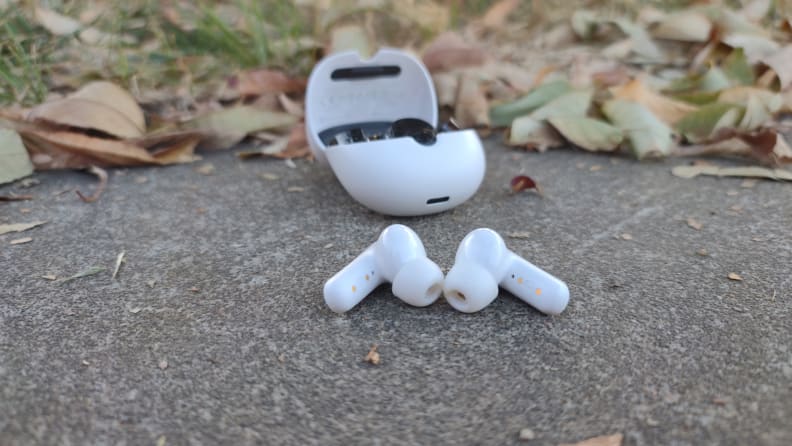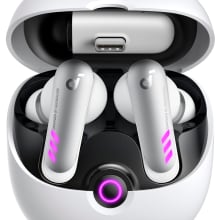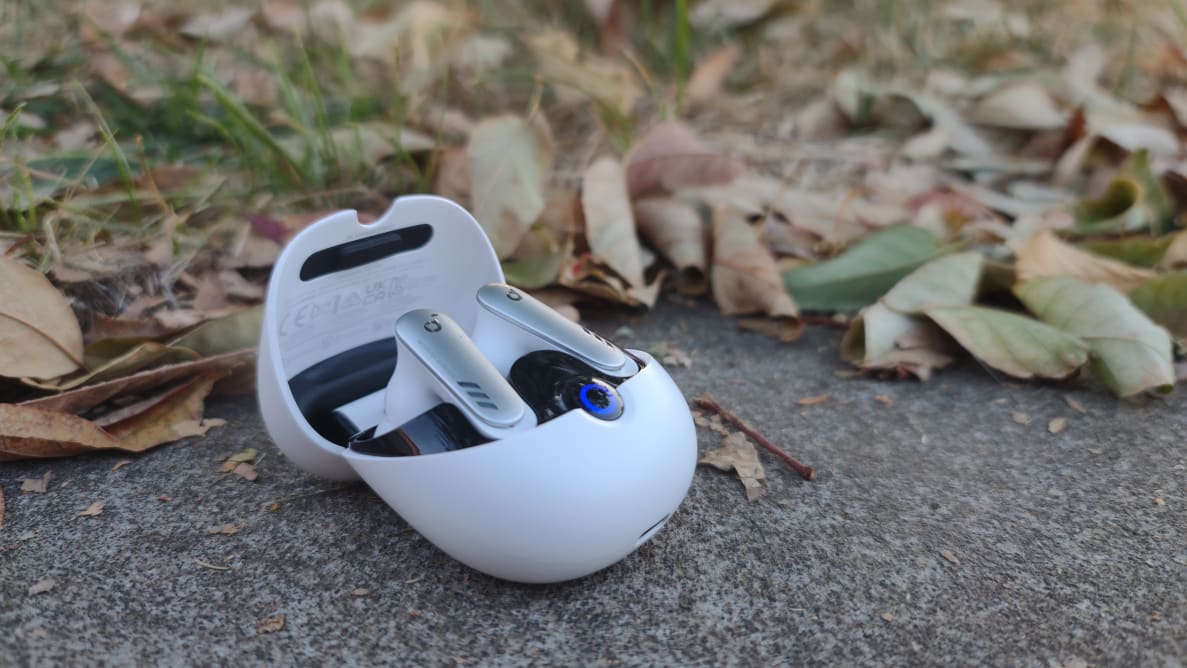Pros
-
Good sound
-
Great gaming features
-
Comfortable design
Cons
-
Lackluster non-gaming features
About the Anker Soundcore VR P10
Here’s a look at the earbuds we tested:
- Price: $80
- Battery life: Up to 6 hours, up to 24 hours total with case
- Drivers: 11mm composite bio-cellulose driver
- Wireless charging: Yes, Qi-compatible case
- Voice Assistant compatibility: Siri at launch, with more assistants coming in future updates
- Colors: White
- Connectivity: Bluetooth 5.2, 2.4Ghz wireless via USB-C dongle
- Audio codecs: SBC, AAC, LC3 over dongle
- Water-resistance: IPX4
- Ear tips: Small, medium, large
- Weight: Earbuds, 10 grams (0.35 ounces), case, 48.6 grams (1.71 ounces)
- Special features: Rapid charging (5 minutes charge for 1 hour of playback), multi-point connection via 2.4GHz dongle
The Anker Soundcore VR P10 come in a wireless charging case that can only be described as a cross between the Apple Airpods charging case and a Pokeball. The latter likeness stems from a black circle in the middle of the case that illuminates when you open it to peer at the buds inside. The lid of the charging case has its own magnetic spot for the buds’ accompanying USB-C dongle to live.
Additional USB-C dongles for multi-device switching are available to purchase for $15 each. One is included with the earbuds, and the VR P10 can support up to four connections between discrete dongles.
What we like
Good overall sound

Soundcore has added a slot for the USB-C dongle in the charging case.
Maybe I shouldn’t have been surprised by the VR P10’s musicality, especially considering how good entries like the Soundcore Liberty Air 2 Pro sound, but I was somewhat taken aback nonetheless.
Even some of the best gaming headsets often over-inflate certain frequencies to place an emphasis on the action of gameplay. But selections like Electric Light Orchestra’s “Mr. Blue Sky,” and Zac Brown Band’s “Jolene,” showed that these buds have plenty of chops outside of being able to replicate gun shots and explosions.
At the same time, the VR P10 produced those other sounds well, too. The 11mm drivers built into each bud make ambient sounds in games like The Elder Scrolls V: Skyrim VR feel stunningly realistic.
There’s also a gaming-specific equalizer available in the accompanying Soundcore app called Super Hearing. Toggling this setting adjusts the earbuds’ sound signature to enhance sounds like gunfire and footsteps, making it an ideal setting to run during FPS gameplay.
There are some points where these earbuds falter, however. The VR P10 errs on the side of average when it comes to bass. Secondly, its selection of different preset equalizers can be somewhat uninspiring at times. Neither nitpick, though, takes away from a stellar overall audio experience with these futuristic little golf tees.
Exciting tech at play
Unlike traditional earbuds, the VR P10 come with a USB-C dongle that fits neatly in the buds’ wireless charging case. When connected to a VR headset like the Meta Quest 2, the dongle switches the earbuds from Bluetooth 5.2 to a 2.4GHz signal.
Technically, the dongle is compatible with several other devices such as the PS4 and PS5, Nintendo Switch, PC, and even smartphones. You can pair up to four dongles across separate devices and switch between each. VR is being targeted most heavily, though, because of what this low-latency tech could mean for the experience.
Bluetooth audio hasn’t been able to achieve the low latency that is a necessity for virtual reality. Oftentimes, the delay between visuals and sounds are palpable enough to take users out of the experience entirely. Soundcore says the VR P10 earbuds can offer less than 30ms latency when paired to a dongle, making for a much more realistic, accurate sound for your VR gameplay.
I’ll be the first to admit that I don’t have the sharpest ear when it comes to latency. That said, in limited VR testing with the earbuds, I couldn’t decipher any noticeable delay between audio and visuals. These buds, alongside competitors like the JBL Quantum TWS, could be remembered as one of the catalysts for revolutionizing the relationship between VR and true wireless audio.
Comfortable design

The VR P10s are comfortable to wear for hours at a time.
The VR P10 won’t win many points for creativity—like many before (and after) them, they have adopted a variation of the stemmed earbud design that the original Apple AirPods.
More importantly, the VR P10 get plenty of credit for offering a seemingly weightless, comfortable fit that endures for lengthy listening sessions. The buds’ battery went long before ear fatigue crept in, which is exactly what one might hope for in gaming earbuds.
Other elements of the VR P10’s design are solid, too. They’re not exactly athletic earbuds, but they are secure enough for brisk walks around the neighborhood. The controls are responsive and customizable in the Soundcore app. The buds’ lighting effect (three glowing, diagonal lines on each bud) can also be toggled between five different colors in the app. Or, if glowing ears isn’t really your thing, you can turn them off and save some battery life.
What we don’t like
Lackluster standard features
Take away the neat technology and sweet gaming perks, and Soundcore’s VR P10 don’t have the tools to keep up with most modern earbuds in their price range. Six hours of battery life is the industry standard nowadays–they should serve you just fine, but won’t last for a marathon gaming session.
The same goes for its weather resistance rating, with the VR P10 maintaining the status quo at IPX4. Gaming may not require a high degree of weather resistance, but for these buds do have utility outside of gameplay, it would have been nice to see them have some beefier specs.
The VR P10 also lack any kind of active noise cancellation or noise reduction, which would have been a handy feature to have for gaming. Even features like auto pause are notably missing from the VR P10’s feature set. They do have a decent microphone built into the earbuds, which was plenty suitable for phone calls and should serve just fine for activities like Discord calls.
It’s obvious that Soundcore put all its chips in the gaming pot, and while that pays off in other ways, these buds take a beating when it comes to standard features that true wireless fans have come to know and love.
Should you buy the Anker Soundcor VR P10?
Yes, as long as you fit the niche

The VR P10 comes with an included 2.4GHz dongle, but others must be purchased separately.
The Soundcore VR P10 offer extraordinary technology and useful features for a very specific part of the true wireless earbuds space. If you’re into gaming, and VR in particular, these earbuds should be on your short list of options to consider. Their of sound quality, comfort, and gaming-heavy tech makes them near impossible to overlook.
If you don’t fit the demo, though, it’s best to keep searching. They simply don’t have standalone features that make them a compelling choice in non-gaming situations. With average battery life and weather resistance and no noise cancellation to speak of, they don’t make sense outside of the use case they focus so much on nailing, ultra-low latency. The JBL Quantum TWS rival Soundcore in the true wireless gaming space, as do the Creative Outlier Pro. Both of these options offer solid noise canceling, adding a bonus feature that can’t be found in the VR P10.
Anker’s Soundcore VR P10 are a valiant first attempt and could be just what you’re looking for if Bluetooth isn’t cutting it. At the very least, they’re a relatively affordable investment that’s teeming with exciting tech. If you’re not using them to game, though? Keep dreaming.

The Anker Soundcore VR P10 provide ultra low-latency audio when gaming.
Meet the tester
Nick Woodard is a tech journalist specializing in all things related to home theater and A/V. His background includes a solid foundation as a sports writer for multiple daily newspapers, and he enjoys hiking and mountain biking in his spare time.
Checking our work.
Our team is here to help you buy the best stuff and love what you own. Our writers, editors, and experts obsess over the products we cover to make sure you're confident and satisfied. Have a different opinion about something we recommend? Email us and we'll compare notes.
Shoot us an email



